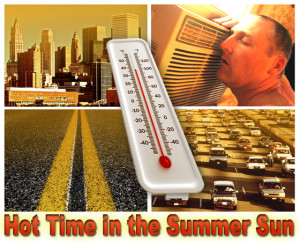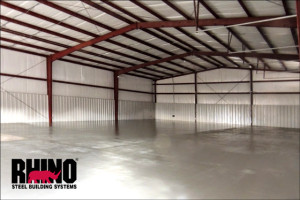What Causes City Temperatures to Soar in Summer?
In part 1 of this series, we covered the basic definition of an urban heat island (UHI). We also revealed twenty U.S. cities which have been 22°F to 28°F warmer than nearby rural areas.
But why are summers in the city so much hotter than surrounding rural locations?
The Main Causes of Urban Heat Island
 DENSITY: Cities are crowded with buildings, streets, highways, and people.
DENSITY: Cities are crowded with buildings, streets, highways, and people.
Over 255 million Americans now live in cities. In some urban areas, like Manhattan Island, the daytime population almost doubles as people commute to work in the city.
Downtown areas run out of space and start building up, creating skyscrapers. Multi-level buildings require multi-level parking garages. With so many surfaces to heat up and hold temperatures, it is no wonder summer temperatures climb.
PAVEMENT: As the number of people traveling within a city increases, so does the need for more roads, highways, and parking.
Asphalt and concrete hold tremendous heat. The Environmental Protection Agency (EPA) estimates pavement covers 30% to 45% of urban areas. According to the EPA, roadway materials can reach temperatures of 120°F to 150°F during the summer. The daytime heat tends to stay trapped in these materials, cooling very, very slowly at night.
EMISSIONS: All the cars, trucks, motorcycles, trains, and buses traveling to and through the cities add to UHI problems. The Database of Road Transportation Emissions estimates urban areas are responsible for 63% of the total annual emissions.
Air conditioners cool inside air and eject hot air outside. The higher the temperature, the more air conditioners are pumping heated air into the surrounding area. Outside temperatures increase even more, forcing air conditioners to work harder, expelling more heated air. It is an unending energy-draining loop.
Greenhouse gasses also increase.
Buildings account for about 35% of all greenhouse gas emissions in America. According to Climate Central, rising greenhouse gasses will drive summer temperatures even higher in the coming years.
LACK of VEGETATION: Growing cities expand, sacrificing areas of vegetation for more room to build. Cooling trees, plants, and grass disappear, replaced by more heat-absorbing infrastructure.
Trees not only supply cooling shade, but also absorb carbon dioxide and other pollutants from the air, releasing clean fresh air back into the atmosphere. Trees actually reduce surrounding air temperatures by as much as 10°F and surface temperatures by 20°F or more.
As the song says, we are “paving paradise to put up a parking lot.”
Keeping It Cool with RHINO Metal Buildings
 RHINO pre-engineered steel buildings offer ways to offset the hot summer sun and the urban heat island effects.
RHINO pre-engineered steel buildings offer ways to offset the hot summer sun and the urban heat island effects.
Our steel buildings create deeper walls than conventional building materials. Filling those wall cavities with thick, energy-saving Pro-Value Insulation decreases air-conditioning and heating usage by 50%.
Choosing optional cool-coated steel exterior panels reduces energy usage another 15% more during the hot summer months.
Want to know more about beating urban heat with steel buildings? Please call RHINO today at 940.383.9566. Get a free estimate on the building of your choice— and learn more about our green, energy-saving products.
